Desklib - Online Library for Study Material and Solved Assignments
VerifiedAdded on 2022/11/29
|15
|3514
|326
AI Summary
Desklib is an online library that offers study material, solved assignments, essays, and dissertations. It provides resources for various subjects, courses, and colleges/universities. Find the content you need to excel in your academic pursuits.
Contribute Materials
Your contribution can guide someone’s learning journey. Share your
documents today.
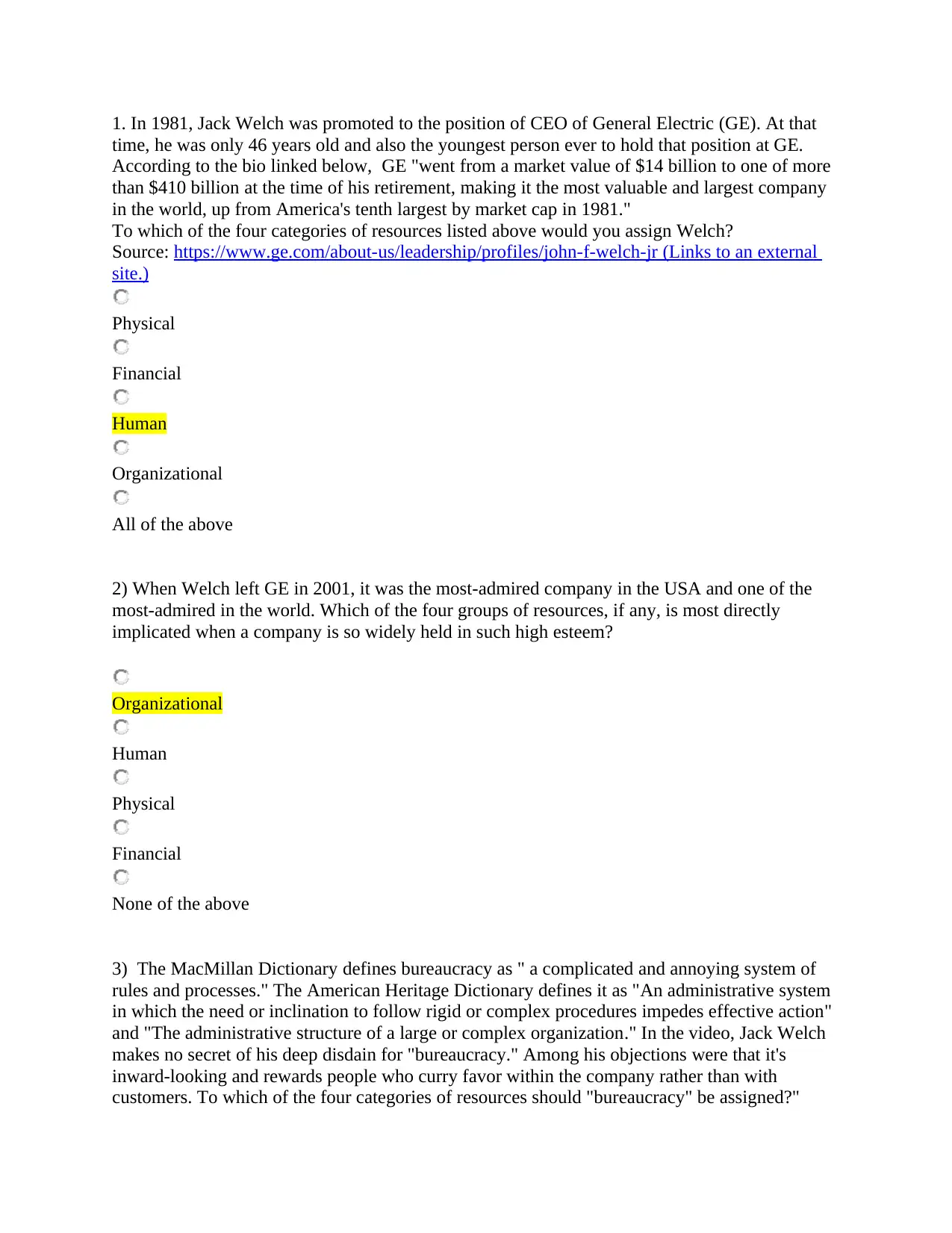
1. In 1981, Jack Welch was promoted to the position of CEO of General Electric (GE). At that
time, he was only 46 years old and also the youngest person ever to hold that position at GE.
According to the bio linked below, GE "went from a market value of $14 billion to one of more
than $410 billion at the time of his retirement, making it the most valuable and largest company
in the world, up from America's tenth largest by market cap in 1981."
To which of the four categories of resources listed above would you assign Welch?
Source: https://www.ge.com/about-us/leadership/profiles/john-f-welch-jr (Links to an external
site.)
Physical
Financial
Human
Organizational
All of the above
2) When Welch left GE in 2001, it was the most-admired company in the USA and one of the
most-admired in the world. Which of the four groups of resources, if any, is most directly
implicated when a company is so widely held in such high esteem?
Organizational
Human
Physical
Financial
None of the above
3) The MacMillan Dictionary defines bureaucracy as " a complicated and annoying system of
rules and processes." The American Heritage Dictionary defines it as "An administrative system
in which the need or inclination to follow rigid or complex procedures impedes effective action"
and "The administrative structure of a large or complex organization." In the video, Jack Welch
makes no secret of his deep disdain for "bureaucracy." Among his objections were that it's
inward-looking and rewards people who curry favor within the company rather than with
customers. To which of the four categories of resources should "bureaucracy" be assigned?"
time, he was only 46 years old and also the youngest person ever to hold that position at GE.
According to the bio linked below, GE "went from a market value of $14 billion to one of more
than $410 billion at the time of his retirement, making it the most valuable and largest company
in the world, up from America's tenth largest by market cap in 1981."
To which of the four categories of resources listed above would you assign Welch?
Source: https://www.ge.com/about-us/leadership/profiles/john-f-welch-jr (Links to an external
site.)
Physical
Financial
Human
Organizational
All of the above
2) When Welch left GE in 2001, it was the most-admired company in the USA and one of the
most-admired in the world. Which of the four groups of resources, if any, is most directly
implicated when a company is so widely held in such high esteem?
Organizational
Human
Physical
Financial
None of the above
3) The MacMillan Dictionary defines bureaucracy as " a complicated and annoying system of
rules and processes." The American Heritage Dictionary defines it as "An administrative system
in which the need or inclination to follow rigid or complex procedures impedes effective action"
and "The administrative structure of a large or complex organization." In the video, Jack Welch
makes no secret of his deep disdain for "bureaucracy." Among his objections were that it's
inward-looking and rewards people who curry favor within the company rather than with
customers. To which of the four categories of resources should "bureaucracy" be assigned?"
Secure Best Marks with AI Grader
Need help grading? Try our AI Grader for instant feedback on your assignments.
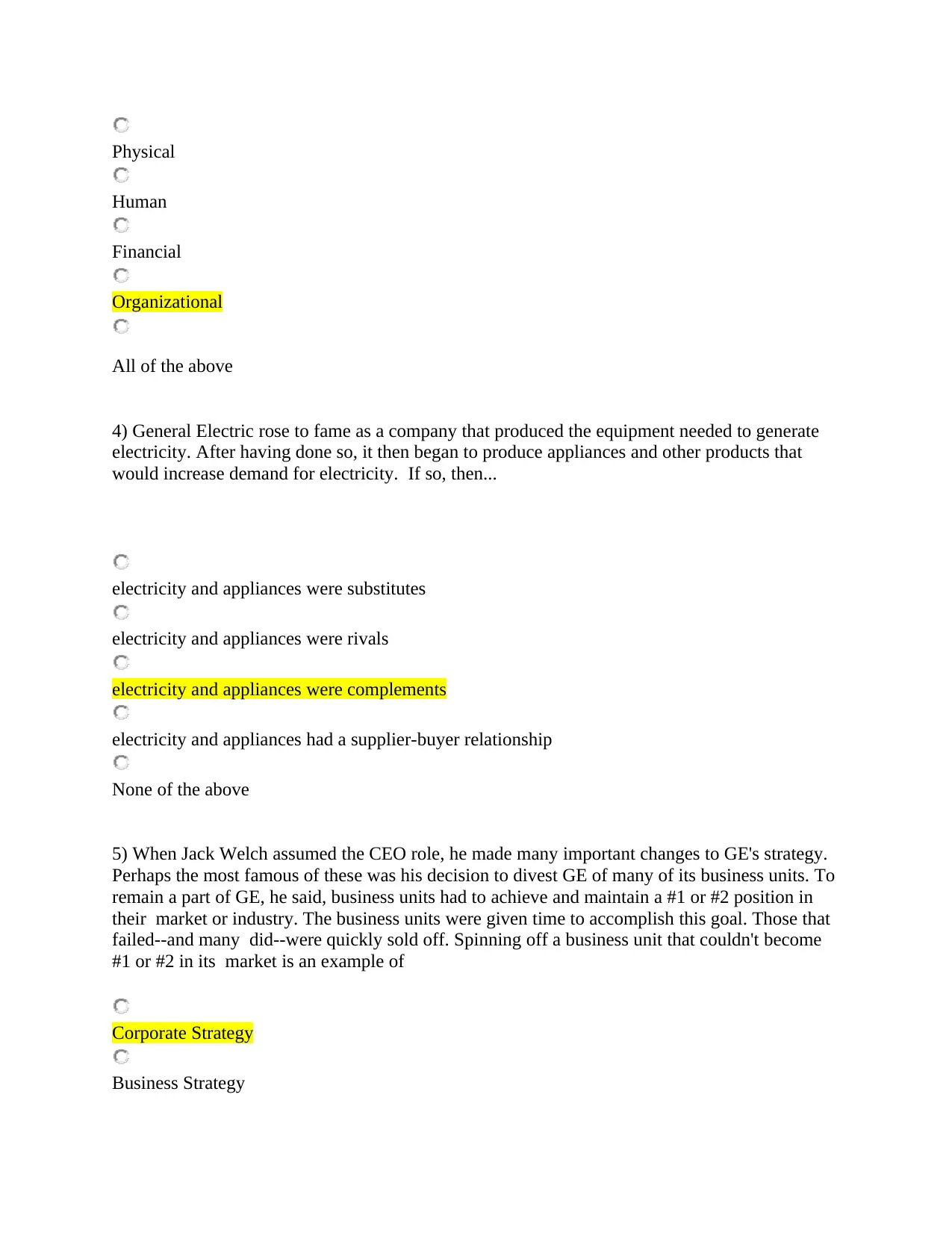
Physical
Human
Financial
Organizational
All of the above
4) General Electric rose to fame as a company that produced the equipment needed to generate
electricity. After having done so, it then began to produce appliances and other products that
would increase demand for electricity. If so, then...
electricity and appliances were substitutes
electricity and appliances were rivals
electricity and appliances were complements
electricity and appliances had a supplier-buyer relationship
None of the above
5) When Jack Welch assumed the CEO role, he made many important changes to GE's strategy.
Perhaps the most famous of these was his decision to divest GE of many of its business units. To
remain a part of GE, he said, business units had to achieve and maintain a #1 or #2 position in
their market or industry. The business units were given time to accomplish this goal. Those that
failed--and many did--were quickly sold off. Spinning off a business unit that couldn't become
#1 or #2 in its market is an example of
Corporate Strategy
Business Strategy
Human
Financial
Organizational
All of the above
4) General Electric rose to fame as a company that produced the equipment needed to generate
electricity. After having done so, it then began to produce appliances and other products that
would increase demand for electricity. If so, then...
electricity and appliances were substitutes
electricity and appliances were rivals
electricity and appliances were complements
electricity and appliances had a supplier-buyer relationship
None of the above
5) When Jack Welch assumed the CEO role, he made many important changes to GE's strategy.
Perhaps the most famous of these was his decision to divest GE of many of its business units. To
remain a part of GE, he said, business units had to achieve and maintain a #1 or #2 position in
their market or industry. The business units were given time to accomplish this goal. Those that
failed--and many did--were quickly sold off. Spinning off a business unit that couldn't become
#1 or #2 in its market is an example of
Corporate Strategy
Business Strategy
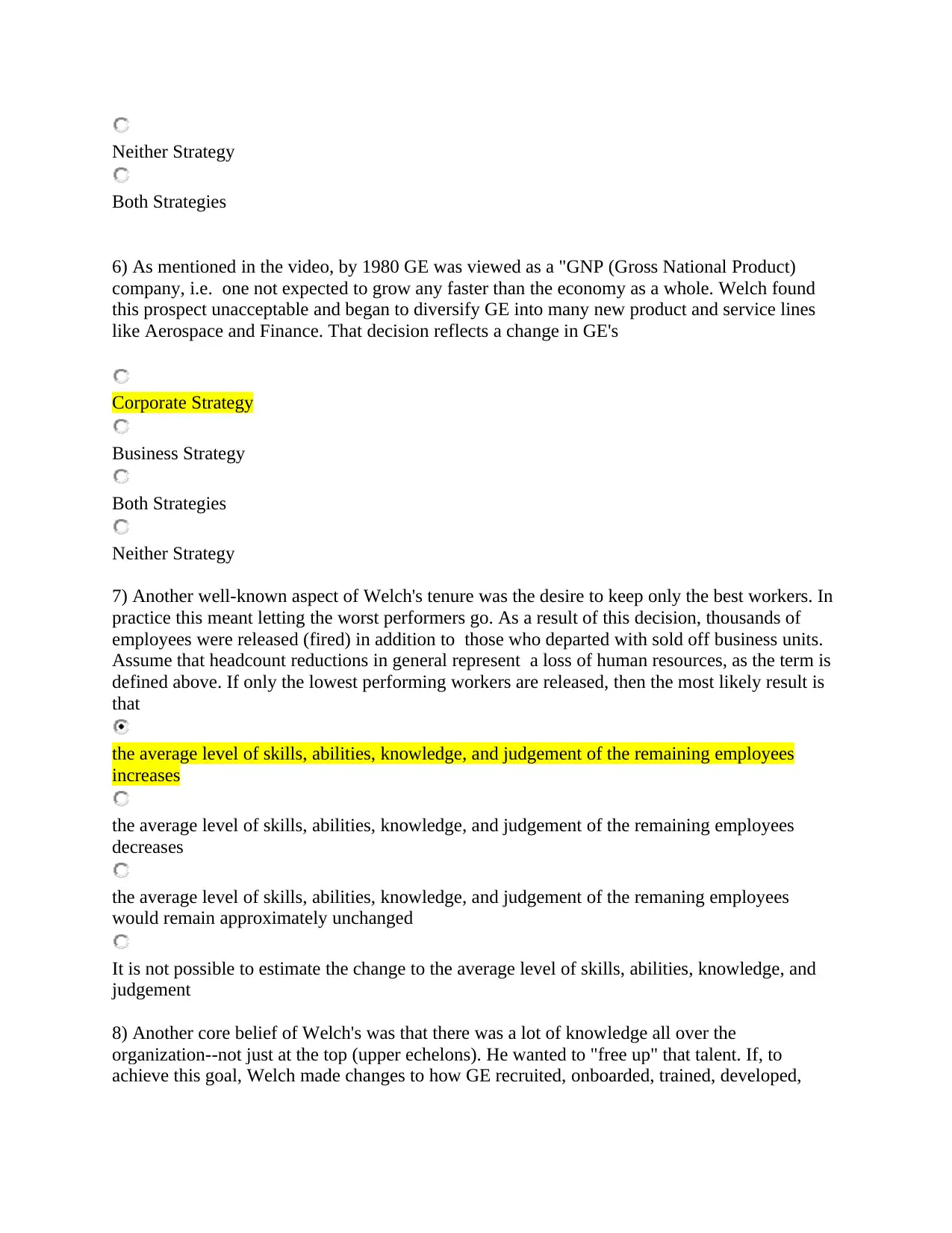
Neither Strategy
Both Strategies
6) As mentioned in the video, by 1980 GE was viewed as a "GNP (Gross National Product)
company, i.e. one not expected to grow any faster than the economy as a whole. Welch found
this prospect unacceptable and began to diversify GE into many new product and service lines
like Aerospace and Finance. That decision reflects a change in GE's
Corporate Strategy
Business Strategy
Both Strategies
Neither Strategy
7) Another well-known aspect of Welch's tenure was the desire to keep only the best workers. In
practice this meant letting the worst performers go. As a result of this decision, thousands of
employees were released (fired) in addition to those who departed with sold off business units.
Assume that headcount reductions in general represent a loss of human resources, as the term is
defined above. If only the lowest performing workers are released, then the most likely result is
that
the average level of skills, abilities, knowledge, and judgement of the remaining employees
increases
the average level of skills, abilities, knowledge, and judgement of the remaining employees
decreases
the average level of skills, abilities, knowledge, and judgement of the remaning employees
would remain approximately unchanged
It is not possible to estimate the change to the average level of skills, abilities, knowledge, and
judgement
8) Another core belief of Welch's was that there was a lot of knowledge all over the
organization--not just at the top (upper echelons). He wanted to "free up" that talent. If, to
achieve this goal, Welch made changes to how GE recruited, onboarded, trained, developed,
Both Strategies
6) As mentioned in the video, by 1980 GE was viewed as a "GNP (Gross National Product)
company, i.e. one not expected to grow any faster than the economy as a whole. Welch found
this prospect unacceptable and began to diversify GE into many new product and service lines
like Aerospace and Finance. That decision reflects a change in GE's
Corporate Strategy
Business Strategy
Both Strategies
Neither Strategy
7) Another well-known aspect of Welch's tenure was the desire to keep only the best workers. In
practice this meant letting the worst performers go. As a result of this decision, thousands of
employees were released (fired) in addition to those who departed with sold off business units.
Assume that headcount reductions in general represent a loss of human resources, as the term is
defined above. If only the lowest performing workers are released, then the most likely result is
that
the average level of skills, abilities, knowledge, and judgement of the remaining employees
increases
the average level of skills, abilities, knowledge, and judgement of the remaining employees
decreases
the average level of skills, abilities, knowledge, and judgement of the remaning employees
would remain approximately unchanged
It is not possible to estimate the change to the average level of skills, abilities, knowledge, and
judgement
8) Another core belief of Welch's was that there was a lot of knowledge all over the
organization--not just at the top (upper echelons). He wanted to "free up" that talent. If, to
achieve this goal, Welch made changes to how GE recruited, onboarded, trained, developed,
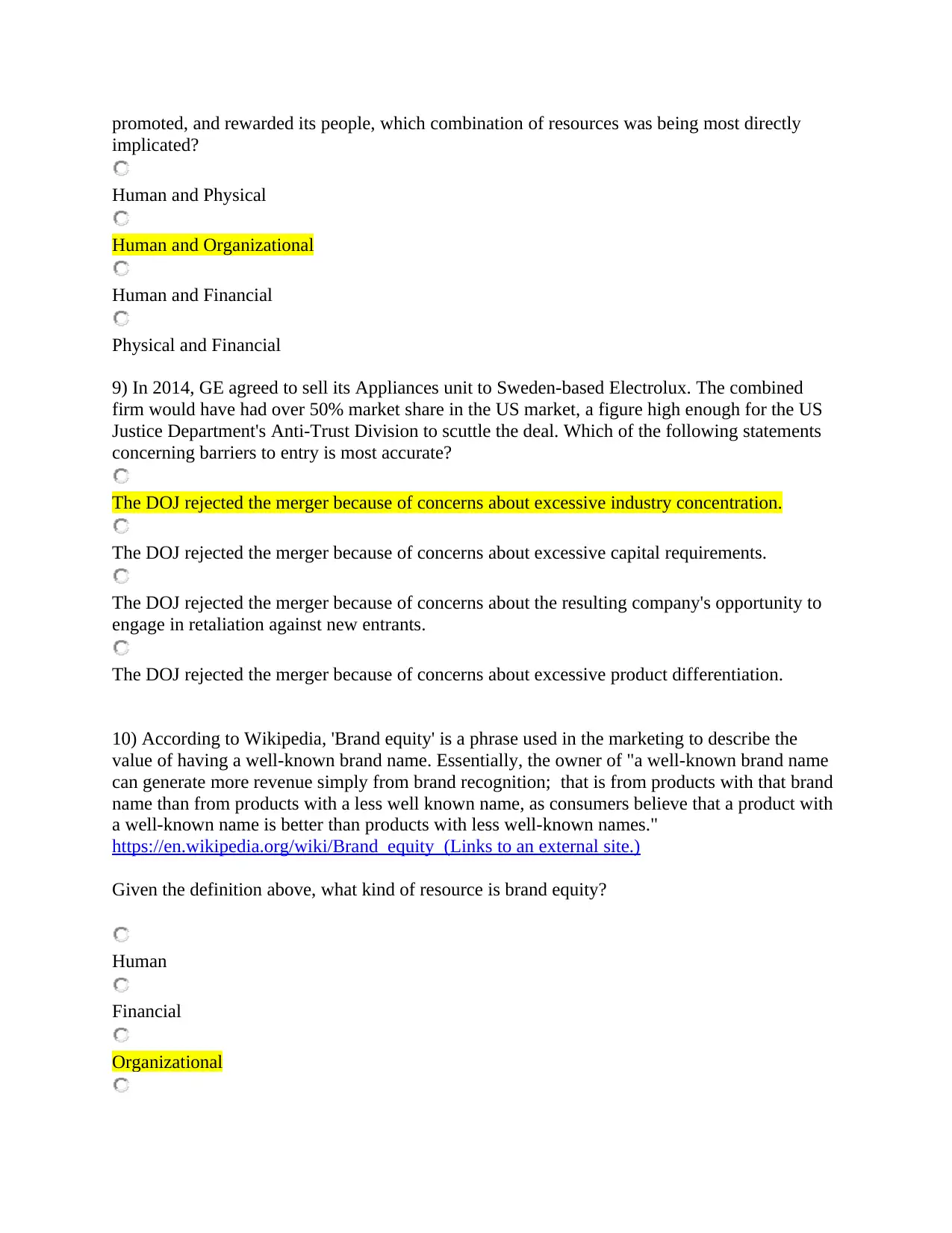
promoted, and rewarded its people, which combination of resources was being most directly
implicated?
Human and Physical
Human and Organizational
Human and Financial
Physical and Financial
9) In 2014, GE agreed to sell its Appliances unit to Sweden-based Electrolux. The combined
firm would have had over 50% market share in the US market, a figure high enough for the US
Justice Department's Anti-Trust Division to scuttle the deal. Which of the following statements
concerning barriers to entry is most accurate?
The DOJ rejected the merger because of concerns about excessive industry concentration.
The DOJ rejected the merger because of concerns about excessive capital requirements.
The DOJ rejected the merger because of concerns about the resulting company's opportunity to
engage in retaliation against new entrants.
The DOJ rejected the merger because of concerns about excessive product differentiation.
10) According to Wikipedia, 'Brand equity' is a phrase used in the marketing to describe the
value of having a well-known brand name. Essentially, the owner of "a well-known brand name
can generate more revenue simply from brand recognition; that is from products with that brand
name than from products with a less well known name, as consumers believe that a product with
a well-known name is better than products with less well-known names."
https://en.wikipedia.org/wiki/Brand_equity (Links to an external site.)
Given the definition above, what kind of resource is brand equity?
Human
Financial
Organizational
implicated?
Human and Physical
Human and Organizational
Human and Financial
Physical and Financial
9) In 2014, GE agreed to sell its Appliances unit to Sweden-based Electrolux. The combined
firm would have had over 50% market share in the US market, a figure high enough for the US
Justice Department's Anti-Trust Division to scuttle the deal. Which of the following statements
concerning barriers to entry is most accurate?
The DOJ rejected the merger because of concerns about excessive industry concentration.
The DOJ rejected the merger because of concerns about excessive capital requirements.
The DOJ rejected the merger because of concerns about the resulting company's opportunity to
engage in retaliation against new entrants.
The DOJ rejected the merger because of concerns about excessive product differentiation.
10) According to Wikipedia, 'Brand equity' is a phrase used in the marketing to describe the
value of having a well-known brand name. Essentially, the owner of "a well-known brand name
can generate more revenue simply from brand recognition; that is from products with that brand
name than from products with a less well known name, as consumers believe that a product with
a well-known name is better than products with less well-known names."
https://en.wikipedia.org/wiki/Brand_equity (Links to an external site.)
Given the definition above, what kind of resource is brand equity?
Human
Financial
Organizational
Secure Best Marks with AI Grader
Need help grading? Try our AI Grader for instant feedback on your assignments.
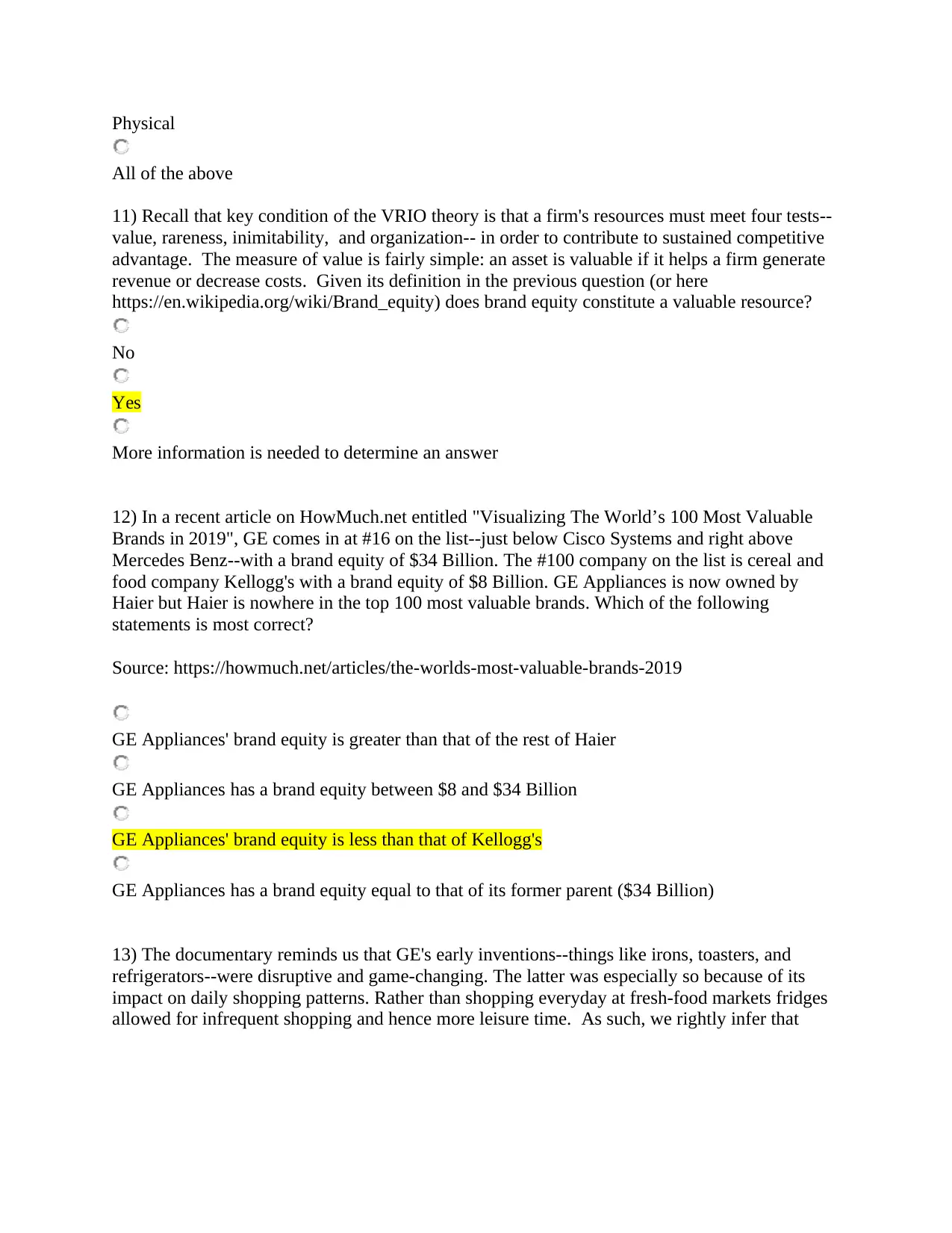
Physical
All of the above
11) Recall that key condition of the VRIO theory is that a firm's resources must meet four tests--
value, rareness, inimitability, and organization-- in order to contribute to sustained competitive
advantage. The measure of value is fairly simple: an asset is valuable if it helps a firm generate
revenue or decrease costs. Given its definition in the previous question (or here
https://en.wikipedia.org/wiki/Brand_equity) does brand equity constitute a valuable resource?
No
Yes
More information is needed to determine an answer
12) In a recent article on HowMuch.net entitled "Visualizing The World’s 100 Most Valuable
Brands in 2019", GE comes in at #16 on the list--just below Cisco Systems and right above
Mercedes Benz--with a brand equity of $34 Billion. The #100 company on the list is cereal and
food company Kellogg's with a brand equity of $8 Billion. GE Appliances is now owned by
Haier but Haier is nowhere in the top 100 most valuable brands. Which of the following
statements is most correct?
Source: https://howmuch.net/articles/the-worlds-most-valuable-brands-2019
GE Appliances' brand equity is greater than that of the rest of Haier
GE Appliances has a brand equity between $8 and $34 Billion
GE Appliances' brand equity is less than that of Kellogg's
GE Appliances has a brand equity equal to that of its former parent ($34 Billion)
13) The documentary reminds us that GE's early inventions--things like irons, toasters, and
refrigerators--were disruptive and game-changing. The latter was especially so because of its
impact on daily shopping patterns. Rather than shopping everyday at fresh-food markets fridges
allowed for infrequent shopping and hence more leisure time. As such, we rightly infer that
All of the above
11) Recall that key condition of the VRIO theory is that a firm's resources must meet four tests--
value, rareness, inimitability, and organization-- in order to contribute to sustained competitive
advantage. The measure of value is fairly simple: an asset is valuable if it helps a firm generate
revenue or decrease costs. Given its definition in the previous question (or here
https://en.wikipedia.org/wiki/Brand_equity) does brand equity constitute a valuable resource?
No
Yes
More information is needed to determine an answer
12) In a recent article on HowMuch.net entitled "Visualizing The World’s 100 Most Valuable
Brands in 2019", GE comes in at #16 on the list--just below Cisco Systems and right above
Mercedes Benz--with a brand equity of $34 Billion. The #100 company on the list is cereal and
food company Kellogg's with a brand equity of $8 Billion. GE Appliances is now owned by
Haier but Haier is nowhere in the top 100 most valuable brands. Which of the following
statements is most correct?
Source: https://howmuch.net/articles/the-worlds-most-valuable-brands-2019
GE Appliances' brand equity is greater than that of the rest of Haier
GE Appliances has a brand equity between $8 and $34 Billion
GE Appliances' brand equity is less than that of Kellogg's
GE Appliances has a brand equity equal to that of its former parent ($34 Billion)
13) The documentary reminds us that GE's early inventions--things like irons, toasters, and
refrigerators--were disruptive and game-changing. The latter was especially so because of its
impact on daily shopping patterns. Rather than shopping everyday at fresh-food markets fridges
allowed for infrequent shopping and hence more leisure time. As such, we rightly infer that
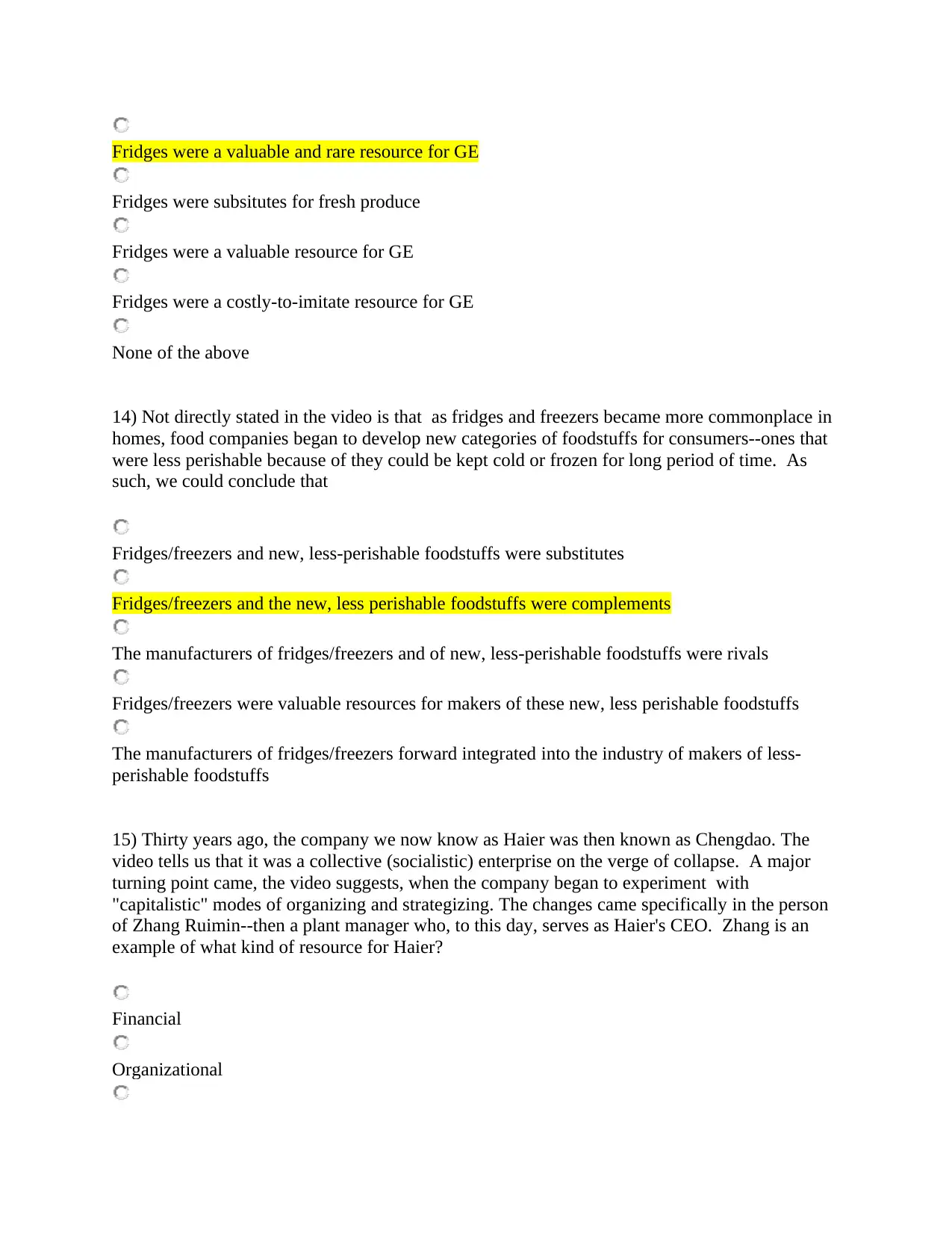
Fridges were a valuable and rare resource for GE
Fridges were subsitutes for fresh produce
Fridges were a valuable resource for GE
Fridges were a costly-to-imitate resource for GE
None of the above
14) Not directly stated in the video is that as fridges and freezers became more commonplace in
homes, food companies began to develop new categories of foodstuffs for consumers--ones that
were less perishable because of they could be kept cold or frozen for long period of time. As
such, we could conclude that
Fridges/freezers and new, less-perishable foodstuffs were substitutes
Fridges/freezers and the new, less perishable foodstuffs were complements
The manufacturers of fridges/freezers and of new, less-perishable foodstuffs were rivals
Fridges/freezers were valuable resources for makers of these new, less perishable foodstuffs
The manufacturers of fridges/freezers forward integrated into the industry of makers of less-
perishable foodstuffs
15) Thirty years ago, the company we now know as Haier was then known as Chengdao. The
video tells us that it was a collective (socialistic) enterprise on the verge of collapse. A major
turning point came, the video suggests, when the company began to experiment with
"capitalistic" modes of organizing and strategizing. The changes came specifically in the person
of Zhang Ruimin--then a plant manager who, to this day, serves as Haier's CEO. Zhang is an
example of what kind of resource for Haier?
Financial
Organizational
Fridges were subsitutes for fresh produce
Fridges were a valuable resource for GE
Fridges were a costly-to-imitate resource for GE
None of the above
14) Not directly stated in the video is that as fridges and freezers became more commonplace in
homes, food companies began to develop new categories of foodstuffs for consumers--ones that
were less perishable because of they could be kept cold or frozen for long period of time. As
such, we could conclude that
Fridges/freezers and new, less-perishable foodstuffs were substitutes
Fridges/freezers and the new, less perishable foodstuffs were complements
The manufacturers of fridges/freezers and of new, less-perishable foodstuffs were rivals
Fridges/freezers were valuable resources for makers of these new, less perishable foodstuffs
The manufacturers of fridges/freezers forward integrated into the industry of makers of less-
perishable foodstuffs
15) Thirty years ago, the company we now know as Haier was then known as Chengdao. The
video tells us that it was a collective (socialistic) enterprise on the verge of collapse. A major
turning point came, the video suggests, when the company began to experiment with
"capitalistic" modes of organizing and strategizing. The changes came specifically in the person
of Zhang Ruimin--then a plant manager who, to this day, serves as Haier's CEO. Zhang is an
example of what kind of resource for Haier?
Financial
Organizational
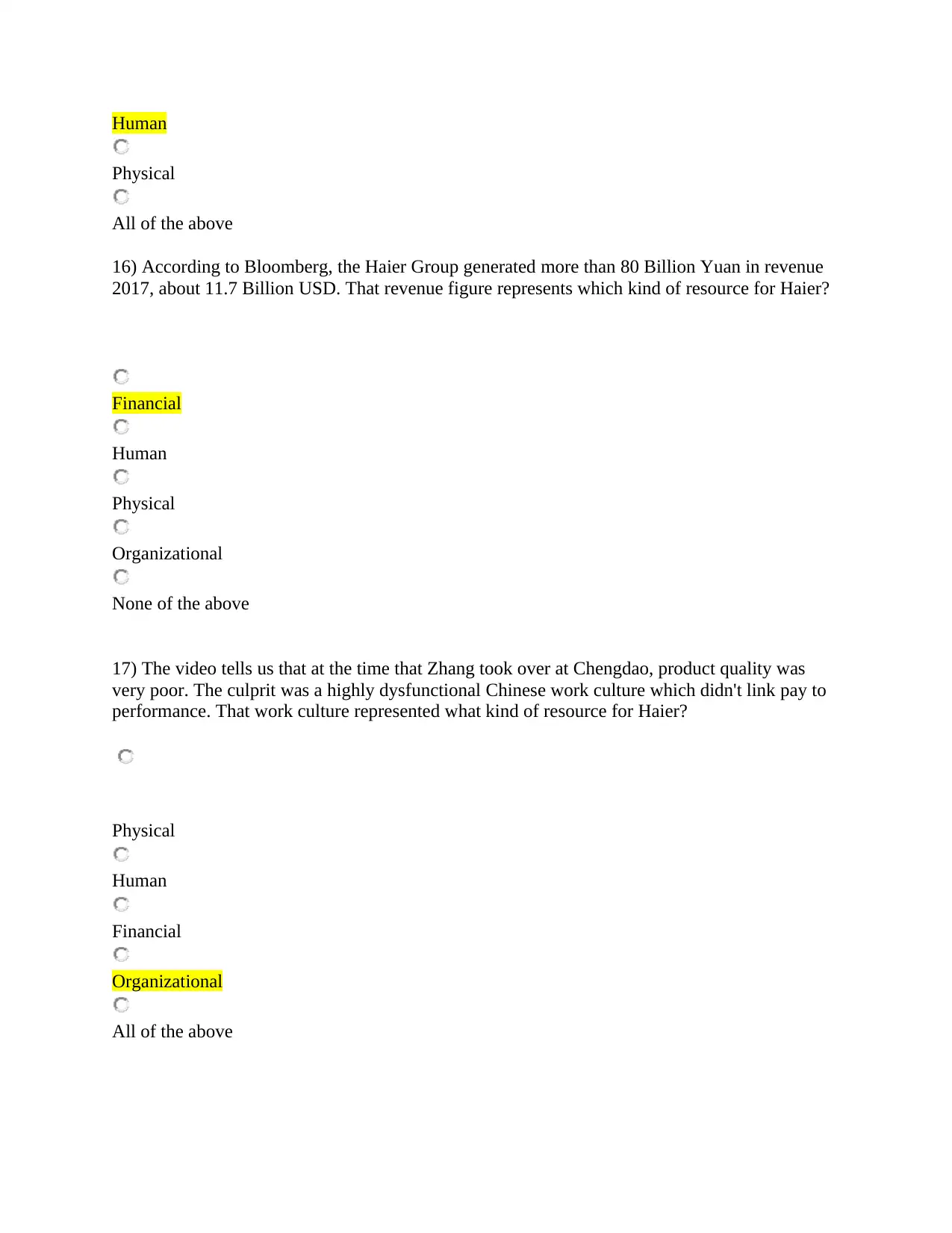
Human
Physical
All of the above
16) According to Bloomberg, the Haier Group generated more than 80 Billion Yuan in revenue
2017, about 11.7 Billion USD. That revenue figure represents which kind of resource for Haier?
Financial
Human
Physical
Organizational
None of the above
17) The video tells us that at the time that Zhang took over at Chengdao, product quality was
very poor. The culprit was a highly dysfunctional Chinese work culture which didn't link pay to
performance. That work culture represented what kind of resource for Haier?
Physical
Human
Financial
Organizational
All of the above
Physical
All of the above
16) According to Bloomberg, the Haier Group generated more than 80 Billion Yuan in revenue
2017, about 11.7 Billion USD. That revenue figure represents which kind of resource for Haier?
Financial
Human
Physical
Organizational
None of the above
17) The video tells us that at the time that Zhang took over at Chengdao, product quality was
very poor. The culprit was a highly dysfunctional Chinese work culture which didn't link pay to
performance. That work culture represented what kind of resource for Haier?
Physical
Human
Financial
Organizational
All of the above
Paraphrase This Document
Need a fresh take? Get an instant paraphrase of this document with our AI Paraphraser
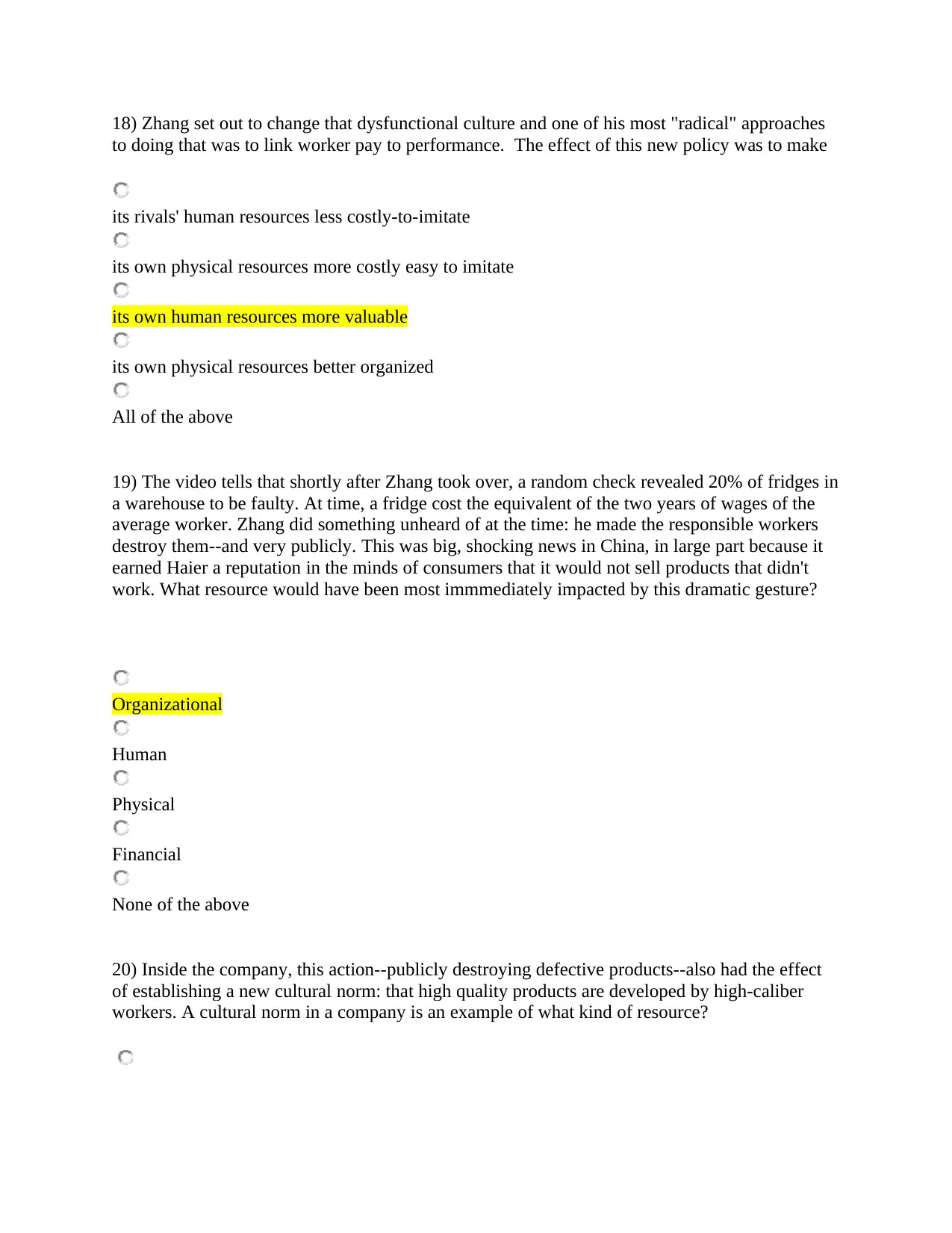
18) Zhang set out to change that dysfunctional culture and one of his most "radical" approaches
to doing that was to link worker pay to performance. The effect of this new policy was to make
its rivals' human resources less costly-to-imitate
its own physical resources more costly easy to imitate
its own human resources more valuable
its own physical resources better organized
All of the above
19) The video tells that shortly after Zhang took over, a random check revealed 20% of fridges in
a warehouse to be faulty. At time, a fridge cost the equivalent of the two years of wages of the
average worker. Zhang did something unheard of at the time: he made the responsible workers
destroy them--and very publicly. This was big, shocking news in China, in large part because it
earned Haier a reputation in the minds of consumers that it would not sell products that didn't
work. What resource would have been most immmediately impacted by this dramatic gesture?
Organizational
Human
Physical
Financial
None of the above
20) Inside the company, this action--publicly destroying defective products--also had the effect
of establishing a new cultural norm: that high quality products are developed by high-caliber
workers. A cultural norm in a company is an example of what kind of resource?
to doing that was to link worker pay to performance. The effect of this new policy was to make
its rivals' human resources less costly-to-imitate
its own physical resources more costly easy to imitate
its own human resources more valuable
its own physical resources better organized
All of the above
19) The video tells that shortly after Zhang took over, a random check revealed 20% of fridges in
a warehouse to be faulty. At time, a fridge cost the equivalent of the two years of wages of the
average worker. Zhang did something unheard of at the time: he made the responsible workers
destroy them--and very publicly. This was big, shocking news in China, in large part because it
earned Haier a reputation in the minds of consumers that it would not sell products that didn't
work. What resource would have been most immmediately impacted by this dramatic gesture?
Organizational
Human
Physical
Financial
None of the above
20) Inside the company, this action--publicly destroying defective products--also had the effect
of establishing a new cultural norm: that high quality products are developed by high-caliber
workers. A cultural norm in a company is an example of what kind of resource?
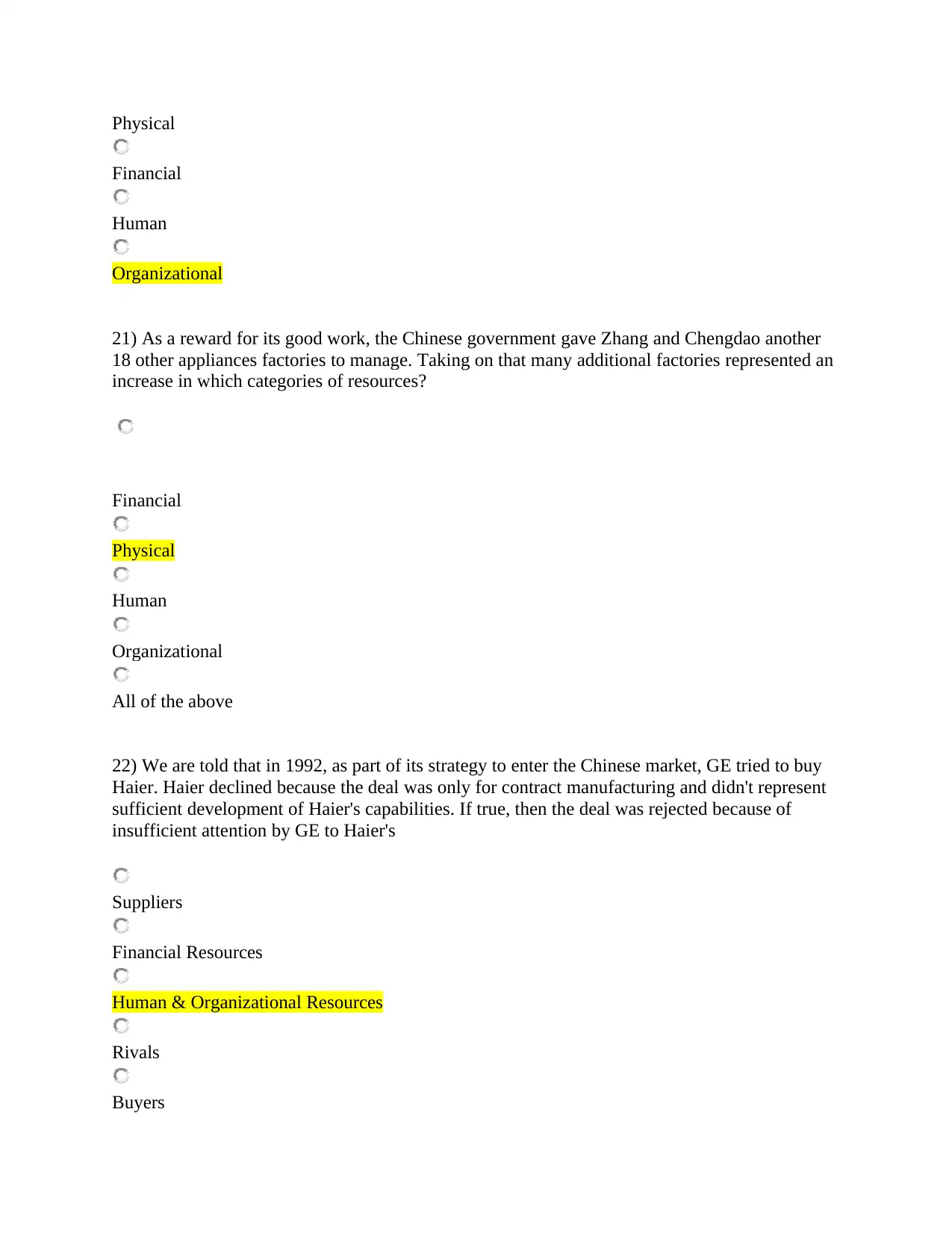
Physical
Financial
Human
Organizational
21) As a reward for its good work, the Chinese government gave Zhang and Chengdao another
18 other appliances factories to manage. Taking on that many additional factories represented an
increase in which categories of resources?
Financial
Physical
Human
Organizational
All of the above
22) We are told that in 1992, as part of its strategy to enter the Chinese market, GE tried to buy
Haier. Haier declined because the deal was only for contract manufacturing and didn't represent
sufficient development of Haier's capabilities. If true, then the deal was rejected because of
insufficient attention by GE to Haier's
Suppliers
Financial Resources
Human & Organizational Resources
Rivals
Buyers
Financial
Human
Organizational
21) As a reward for its good work, the Chinese government gave Zhang and Chengdao another
18 other appliances factories to manage. Taking on that many additional factories represented an
increase in which categories of resources?
Financial
Physical
Human
Organizational
All of the above
22) We are told that in 1992, as part of its strategy to enter the Chinese market, GE tried to buy
Haier. Haier declined because the deal was only for contract manufacturing and didn't represent
sufficient development of Haier's capabilities. If true, then the deal was rejected because of
insufficient attention by GE to Haier's
Suppliers
Financial Resources
Human & Organizational Resources
Rivals
Buyers
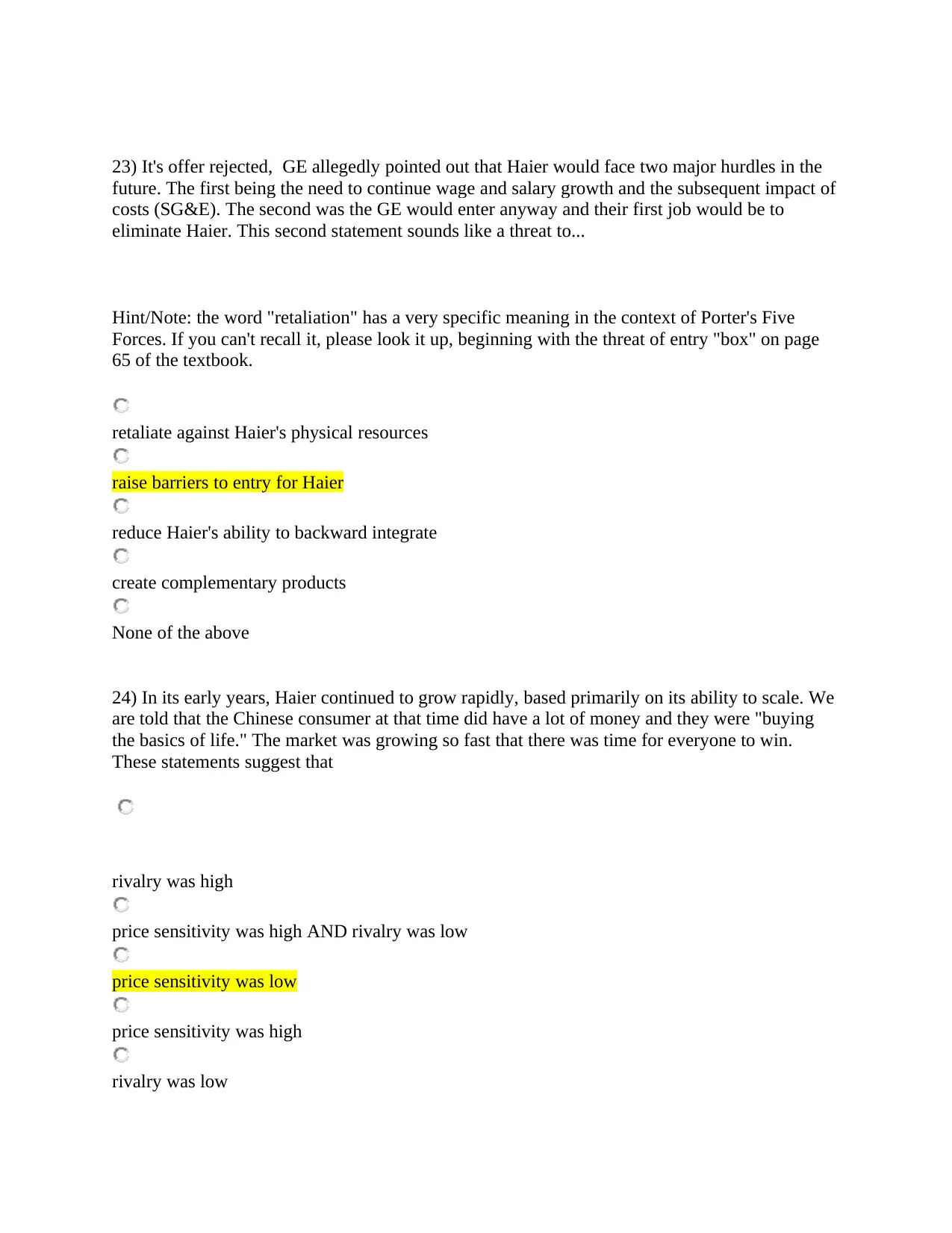
23) It's offer rejected, GE allegedly pointed out that Haier would face two major hurdles in the
future. The first being the need to continue wage and salary growth and the subsequent impact of
costs (SG&E). The second was the GE would enter anyway and their first job would be to
eliminate Haier. This second statement sounds like a threat to...
Hint/Note: the word "retaliation" has a very specific meaning in the context of Porter's Five
Forces. If you can't recall it, please look it up, beginning with the threat of entry "box" on page
65 of the textbook.
retaliate against Haier's physical resources
raise barriers to entry for Haier
reduce Haier's ability to backward integrate
create complementary products
None of the above
24) In its early years, Haier continued to grow rapidly, based primarily on its ability to scale. We
are told that the Chinese consumer at that time did have a lot of money and they were "buying
the basics of life." The market was growing so fast that there was time for everyone to win.
These statements suggest that
rivalry was high
price sensitivity was high AND rivalry was low
price sensitivity was low
price sensitivity was high
rivalry was low
future. The first being the need to continue wage and salary growth and the subsequent impact of
costs (SG&E). The second was the GE would enter anyway and their first job would be to
eliminate Haier. This second statement sounds like a threat to...
Hint/Note: the word "retaliation" has a very specific meaning in the context of Porter's Five
Forces. If you can't recall it, please look it up, beginning with the threat of entry "box" on page
65 of the textbook.
retaliate against Haier's physical resources
raise barriers to entry for Haier
reduce Haier's ability to backward integrate
create complementary products
None of the above
24) In its early years, Haier continued to grow rapidly, based primarily on its ability to scale. We
are told that the Chinese consumer at that time did have a lot of money and they were "buying
the basics of life." The market was growing so fast that there was time for everyone to win.
These statements suggest that
rivalry was high
price sensitivity was high AND rivalry was low
price sensitivity was low
price sensitivity was high
rivalry was low
Secure Best Marks with AI Grader
Need help grading? Try our AI Grader for instant feedback on your assignments.
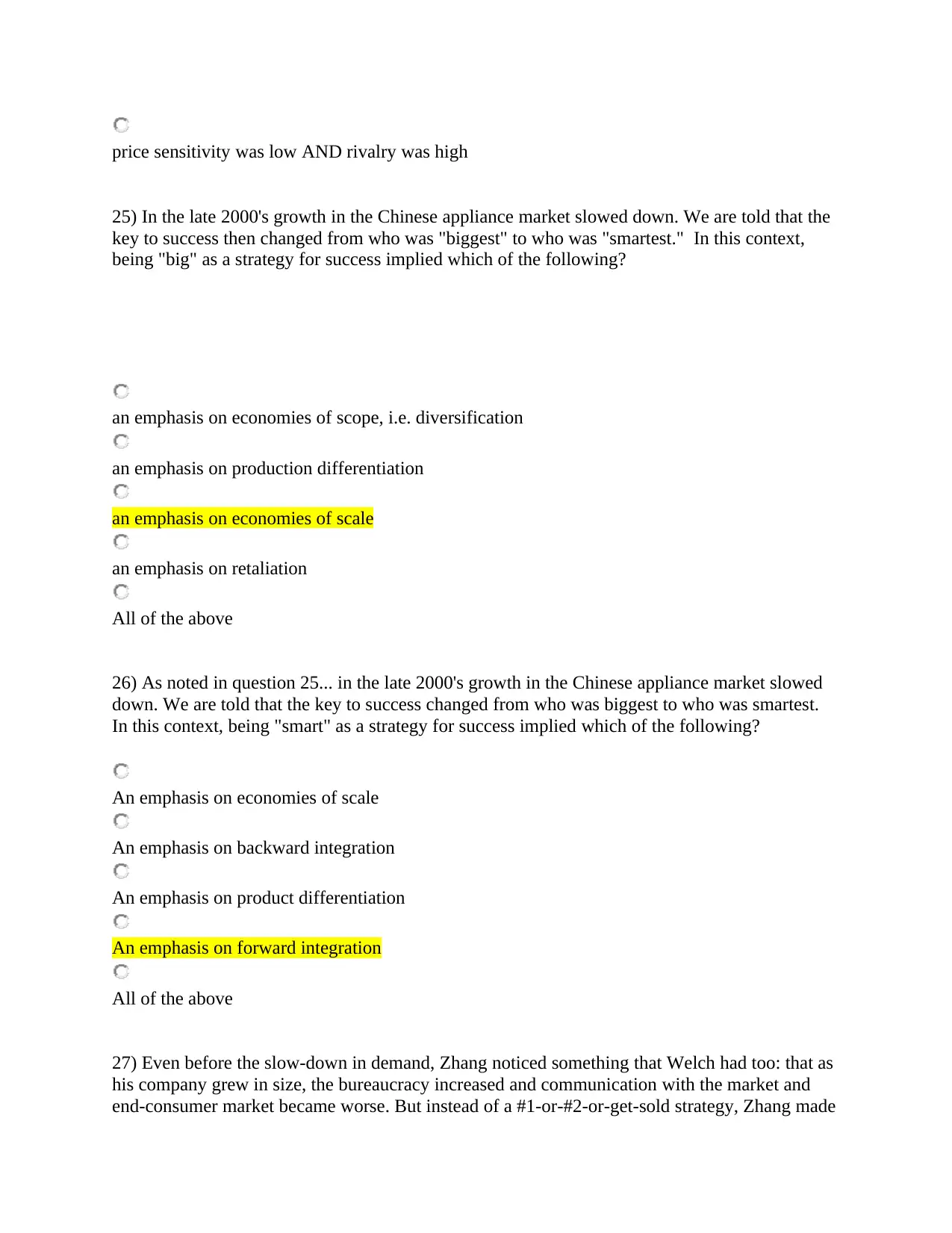
price sensitivity was low AND rivalry was high
25) In the late 2000's growth in the Chinese appliance market slowed down. We are told that the
key to success then changed from who was "biggest" to who was "smartest." In this context,
being "big" as a strategy for success implied which of the following?
an emphasis on economies of scope, i.e. diversification
an emphasis on production differentiation
an emphasis on economies of scale
an emphasis on retaliation
All of the above
26) As noted in question 25... in the late 2000's growth in the Chinese appliance market slowed
down. We are told that the key to success changed from who was biggest to who was smartest.
In this context, being "smart" as a strategy for success implied which of the following?
An emphasis on economies of scale
An emphasis on backward integration
An emphasis on product differentiation
An emphasis on forward integration
All of the above
27) Even before the slow-down in demand, Zhang noticed something that Welch had too: that as
his company grew in size, the bureaucracy increased and communication with the market and
end-consumer market became worse. But instead of a #1-or-#2-or-get-sold strategy, Zhang made
25) In the late 2000's growth in the Chinese appliance market slowed down. We are told that the
key to success then changed from who was "biggest" to who was "smartest." In this context,
being "big" as a strategy for success implied which of the following?
an emphasis on economies of scope, i.e. diversification
an emphasis on production differentiation
an emphasis on economies of scale
an emphasis on retaliation
All of the above
26) As noted in question 25... in the late 2000's growth in the Chinese appliance market slowed
down. We are told that the key to success changed from who was biggest to who was smartest.
In this context, being "smart" as a strategy for success implied which of the following?
An emphasis on economies of scale
An emphasis on backward integration
An emphasis on product differentiation
An emphasis on forward integration
All of the above
27) Even before the slow-down in demand, Zhang noticed something that Welch had too: that as
his company grew in size, the bureaucracy increased and communication with the market and
end-consumer market became worse. But instead of a #1-or-#2-or-get-sold strategy, Zhang made
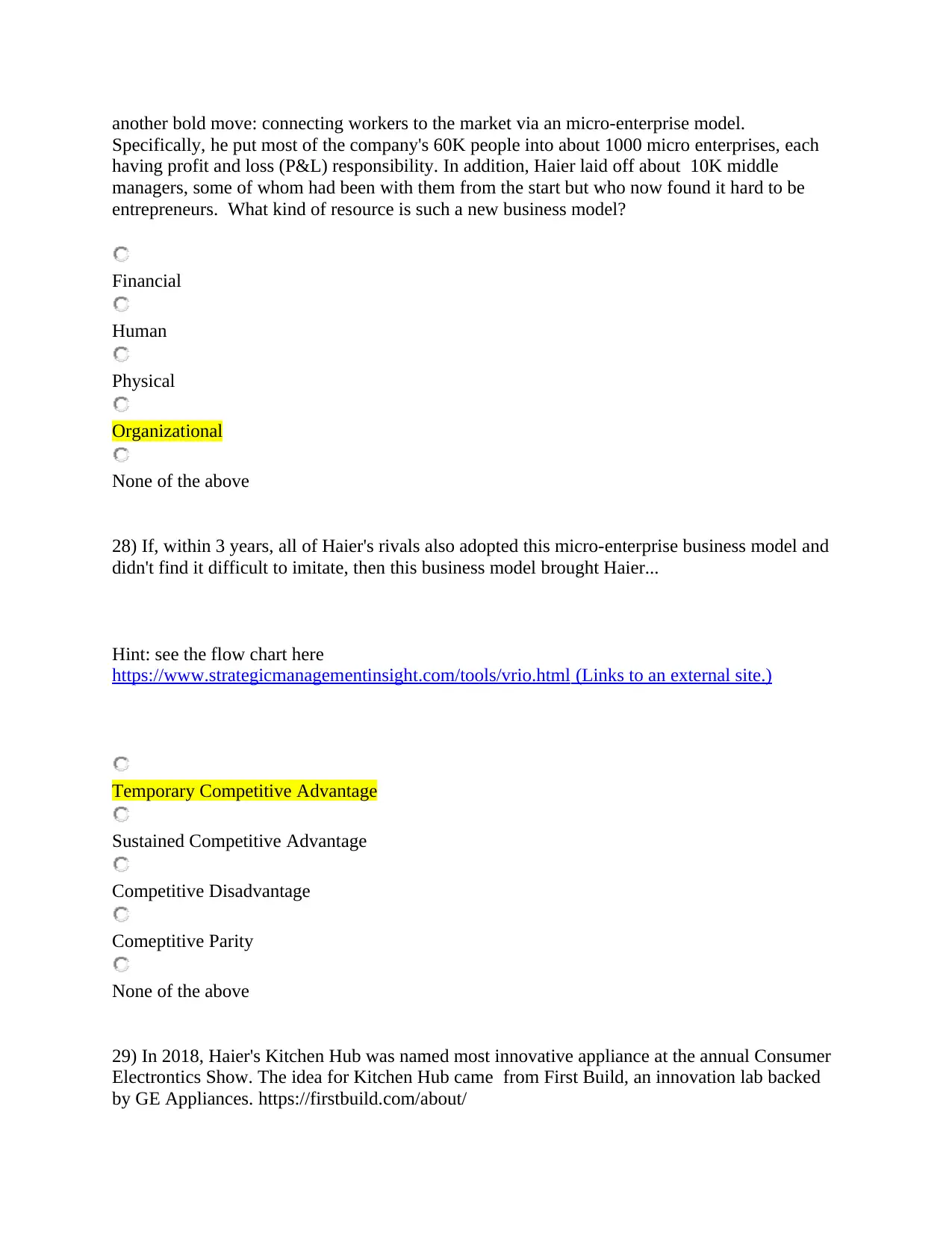
another bold move: connecting workers to the market via an micro-enterprise model.
Specifically, he put most of the company's 60K people into about 1000 micro enterprises, each
having profit and loss (P&L) responsibility. In addition, Haier laid off about 10K middle
managers, some of whom had been with them from the start but who now found it hard to be
entrepreneurs. What kind of resource is such a new business model?
Financial
Human
Physical
Organizational
None of the above
28) If, within 3 years, all of Haier's rivals also adopted this micro-enterprise business model and
didn't find it difficult to imitate, then this business model brought Haier...
Hint: see the flow chart here
https://www.strategicmanagementinsight.com/tools/vrio.html (Links to an external site.)
Temporary Competitive Advantage
Sustained Competitive Advantage
Competitive Disadvantage
Comeptitive Parity
None of the above
29) In 2018, Haier's Kitchen Hub was named most innovative appliance at the annual Consumer
Electrontics Show. The idea for Kitchen Hub came from First Build, an innovation lab backed
by GE Appliances. https://firstbuild.com/about/
Specifically, he put most of the company's 60K people into about 1000 micro enterprises, each
having profit and loss (P&L) responsibility. In addition, Haier laid off about 10K middle
managers, some of whom had been with them from the start but who now found it hard to be
entrepreneurs. What kind of resource is such a new business model?
Financial
Human
Physical
Organizational
None of the above
28) If, within 3 years, all of Haier's rivals also adopted this micro-enterprise business model and
didn't find it difficult to imitate, then this business model brought Haier...
Hint: see the flow chart here
https://www.strategicmanagementinsight.com/tools/vrio.html (Links to an external site.)
Temporary Competitive Advantage
Sustained Competitive Advantage
Competitive Disadvantage
Comeptitive Parity
None of the above
29) In 2018, Haier's Kitchen Hub was named most innovative appliance at the annual Consumer
Electrontics Show. The idea for Kitchen Hub came from First Build, an innovation lab backed
by GE Appliances. https://firstbuild.com/about/
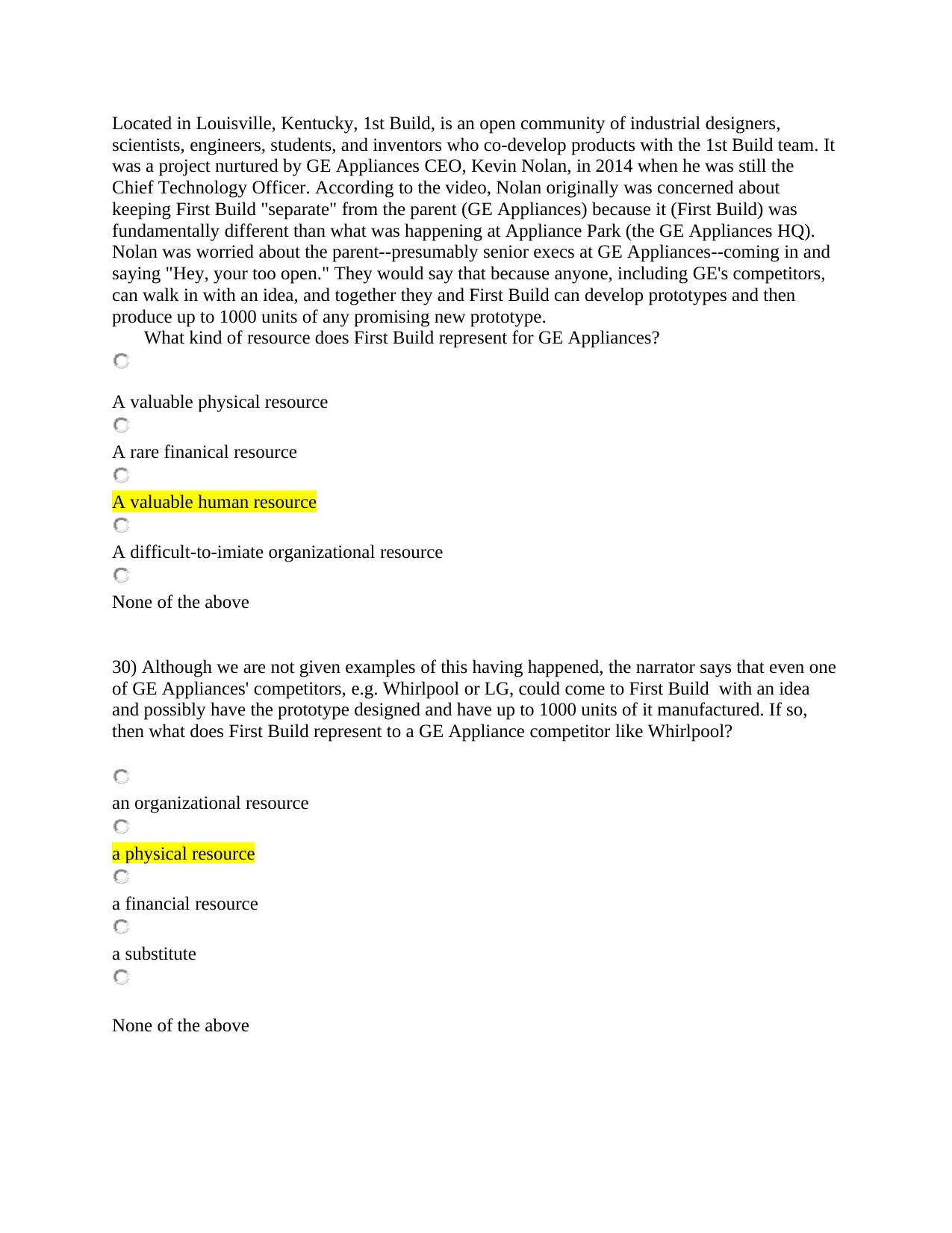
Located in Louisville, Kentucky, 1st Build, is an open community of industrial designers,
scientists, engineers, students, and inventors who co-develop products with the 1st Build team. It
was a project nurtured by GE Appliances CEO, Kevin Nolan, in 2014 when he was still the
Chief Technology Officer. According to the video, Nolan originally was concerned about
keeping First Build "separate" from the parent (GE Appliances) because it (First Build) was
fundamentally different than what was happening at Appliance Park (the GE Appliances HQ).
Nolan was worried about the parent--presumably senior execs at GE Appliances--coming in and
saying "Hey, your too open." They would say that because anyone, including GE's competitors,
can walk in with an idea, and together they and First Build can develop prototypes and then
produce up to 1000 units of any promising new prototype.
What kind of resource does First Build represent for GE Appliances?
A valuable physical resource
A rare finanical resource
A valuable human resource
A difficult-to-imiate organizational resource
None of the above
30) Although we are not given examples of this having happened, the narrator says that even one
of GE Appliances' competitors, e.g. Whirlpool or LG, could come to First Build with an idea
and possibly have the prototype designed and have up to 1000 units of it manufactured. If so,
then what does First Build represent to a GE Appliance competitor like Whirlpool?
an organizational resource
a physical resource
a financial resource
a substitute
None of the above
scientists, engineers, students, and inventors who co-develop products with the 1st Build team. It
was a project nurtured by GE Appliances CEO, Kevin Nolan, in 2014 when he was still the
Chief Technology Officer. According to the video, Nolan originally was concerned about
keeping First Build "separate" from the parent (GE Appliances) because it (First Build) was
fundamentally different than what was happening at Appliance Park (the GE Appliances HQ).
Nolan was worried about the parent--presumably senior execs at GE Appliances--coming in and
saying "Hey, your too open." They would say that because anyone, including GE's competitors,
can walk in with an idea, and together they and First Build can develop prototypes and then
produce up to 1000 units of any promising new prototype.
What kind of resource does First Build represent for GE Appliances?
A valuable physical resource
A rare finanical resource
A valuable human resource
A difficult-to-imiate organizational resource
None of the above
30) Although we are not given examples of this having happened, the narrator says that even one
of GE Appliances' competitors, e.g. Whirlpool or LG, could come to First Build with an idea
and possibly have the prototype designed and have up to 1000 units of it manufactured. If so,
then what does First Build represent to a GE Appliance competitor like Whirlpool?
an organizational resource
a physical resource
a financial resource
a substitute
None of the above
Paraphrase This Document
Need a fresh take? Get an instant paraphrase of this document with our AI Paraphraser
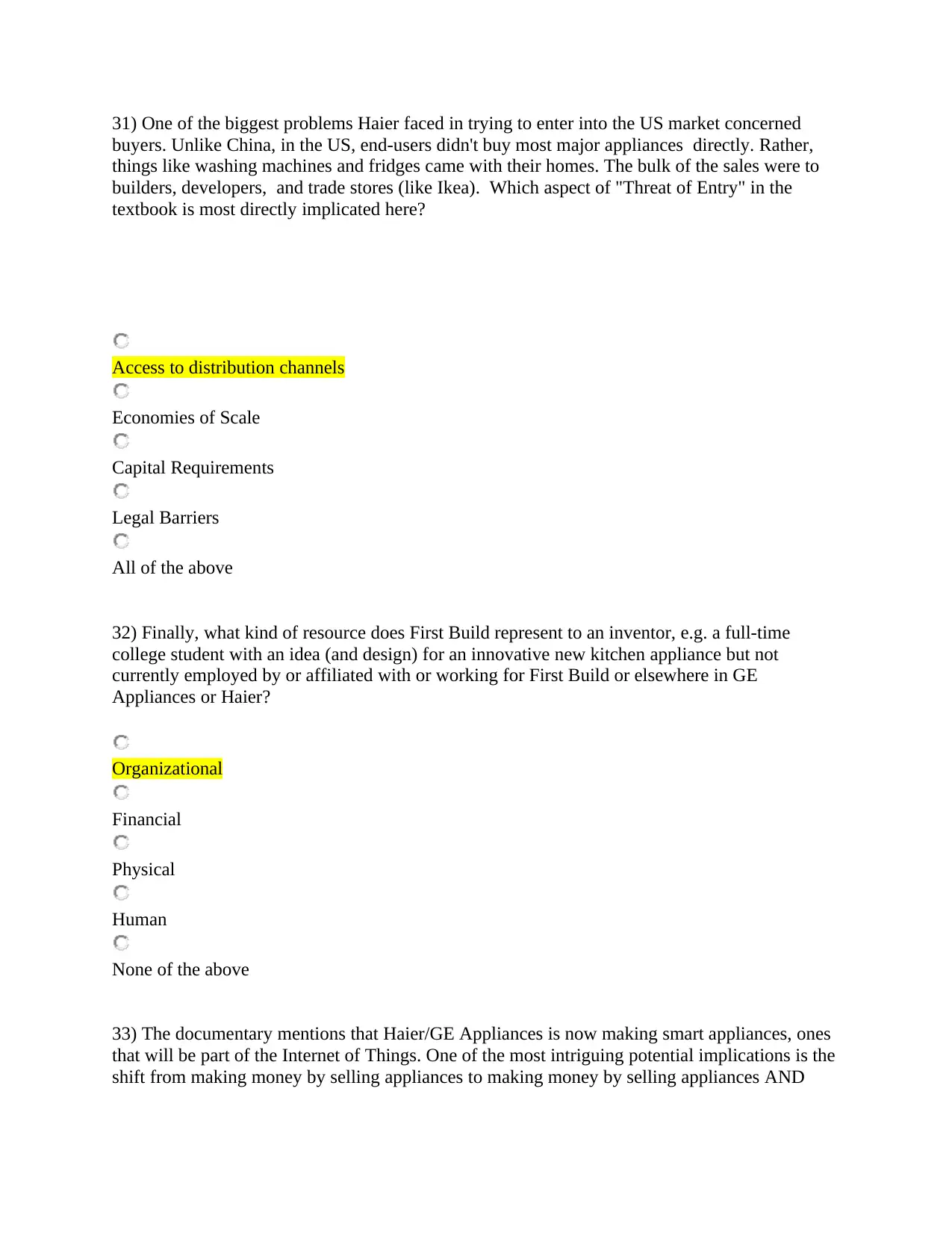
31) One of the biggest problems Haier faced in trying to enter into the US market concerned
buyers. Unlike China, in the US, end-users didn't buy most major appliances directly. Rather,
things like washing machines and fridges came with their homes. The bulk of the sales were to
builders, developers, and trade stores (like Ikea). Which aspect of "Threat of Entry" in the
textbook is most directly implicated here?
Access to distribution channels
Economies of Scale
Capital Requirements
Legal Barriers
All of the above
32) Finally, what kind of resource does First Build represent to an inventor, e.g. a full-time
college student with an idea (and design) for an innovative new kitchen appliance but not
currently employed by or affiliated with or working for First Build or elsewhere in GE
Appliances or Haier?
Organizational
Financial
Physical
Human
None of the above
33) The documentary mentions that Haier/GE Appliances is now making smart appliances, ones
that will be part of the Internet of Things. One of the most intriguing potential implications is the
shift from making money by selling appliances to making money by selling appliances AND
buyers. Unlike China, in the US, end-users didn't buy most major appliances directly. Rather,
things like washing machines and fridges came with their homes. The bulk of the sales were to
builders, developers, and trade stores (like Ikea). Which aspect of "Threat of Entry" in the
textbook is most directly implicated here?
Access to distribution channels
Economies of Scale
Capital Requirements
Legal Barriers
All of the above
32) Finally, what kind of resource does First Build represent to an inventor, e.g. a full-time
college student with an idea (and design) for an innovative new kitchen appliance but not
currently employed by or affiliated with or working for First Build or elsewhere in GE
Appliances or Haier?
Organizational
Financial
Physical
Human
None of the above
33) The documentary mentions that Haier/GE Appliances is now making smart appliances, ones
that will be part of the Internet of Things. One of the most intriguing potential implications is the
shift from making money by selling appliances to making money by selling appliances AND

services, e.g. recipes, cooking classes, etc. that support or increase the value of the appliances. If
such a shift materializes, it reflects a change in GE Appliance/Haier's
Business Strategy
Corporate Strategy
Service Strategy
Neither Strategy
34) Haier became world's top appliance brand in 2009 but slower growth in China meant they
needed to expand internationally. They eventually decided to buy (acquire) their way into
developed markets like Japan and New Zealand. In the US, Haier was able to enter by way of the
acquisition of GE Appliances for $5.6 Billion. At the time of the acquisition, GE was no longer
the market leader, it had fallen behind Korean's Samsung and LG. Its culture was one that was
deeply invested in "variance reduction" and "operational excellence." What the new parent,
Haier, wanted was surprises in organization, business model, and products. Thus, in this time
period,
Haier de-emphasized product differentiation
GE Appliances emphasized economies of scale
Haier de-emphasized economies of scale
GE Appliances emphasized product differentiation
None of the above
such a shift materializes, it reflects a change in GE Appliance/Haier's
Business Strategy
Corporate Strategy
Service Strategy
Neither Strategy
34) Haier became world's top appliance brand in 2009 but slower growth in China meant they
needed to expand internationally. They eventually decided to buy (acquire) their way into
developed markets like Japan and New Zealand. In the US, Haier was able to enter by way of the
acquisition of GE Appliances for $5.6 Billion. At the time of the acquisition, GE was no longer
the market leader, it had fallen behind Korean's Samsung and LG. Its culture was one that was
deeply invested in "variance reduction" and "operational excellence." What the new parent,
Haier, wanted was surprises in organization, business model, and products. Thus, in this time
period,
Haier de-emphasized product differentiation
GE Appliances emphasized economies of scale
Haier de-emphasized economies of scale
GE Appliances emphasized product differentiation
None of the above
1 out of 15
Your All-in-One AI-Powered Toolkit for Academic Success.
+13062052269
info@desklib.com
Available 24*7 on WhatsApp / Email
![[object Object]](/_next/static/media/star-bottom.7253800d.svg)
Unlock your academic potential
© 2024 | Zucol Services PVT LTD | All rights reserved.



